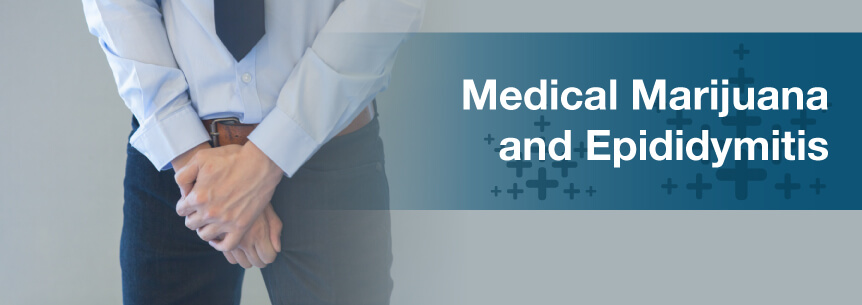
Epididymitis is a condition marked by inflammation and pain. And while epididymitis typically gets better after taking antibiotics, they don’t help with the pain, anxiety and depression you feel while you wait for the antibiotics to work. Fortunately, medical marijuana for epididymitis can be effective at treating these and many other symptoms.
Researchers have conducted numerous studies on the efficacy of medical marijuana treatment for pain. While the pain-relieving effects of medical marijuana are often found to be mild, they do exist. Furthermore, they seem to be more effective for some users than others, showing medical marijuana can be a safe substitute for potentially dangerous pain medications.
According to Dr. Mark Wallace of the University of California’s Center for Medicinal Cannabis Research, a study of fifteen individuals was conducted using smoked cannabis to treat medically induced pain. The study showed a medium dose of cannabis resulted in a noticeable reduction in pain. However, it also revealed a high dose increased pain.
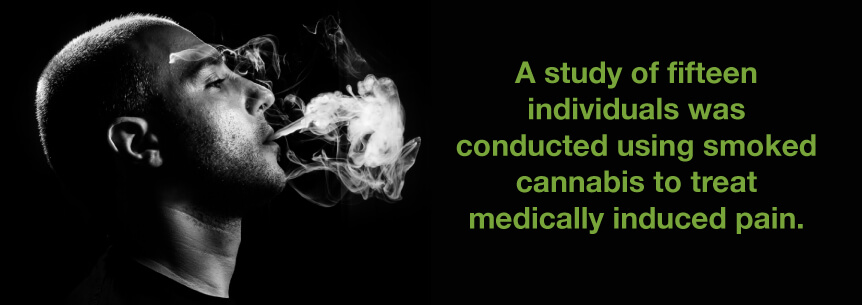
The reason for this increase in pain for some of the study’s participants is unknown. A doctor can prescribe the proper dose for dealing with epididymitis pain. As per their objective, the Center for Medicinal Cannabis Research will continue to research the treatment possibilities for medical marijuana, including pain.
Find A Doctor Find A Dispensary
Anecdotal evidence for the efficacy of medical marijuana as treatment for pain dates back as far as the beginning of the Current Era. That is more than two thousand years of people using marijuana to relieve their pain. Even a physician in Roman Emperor Nero’s army was a proponent for the use of medical marijuana to relieve pain. History also shows respect for the intoxicating nature of the plant with 15th-century Muslim law allowing medicinal use of marijuana, but not recreational use.
Like many other medicinal plants, it took some time before its use carried over into modern western medicine. Nonetheless, as early as the 1800s, we’ve seen mentions of plant’s efficacy as a medical treatment. Since that time, sufferers with a variety of ailments have testified to the ability of marijuana to relieve the pain caused by their sundry conditions. Like most pain medications, it works for some conditions and some patients, but not for others. Its potential to ease the pain of epididymitis cannot be ignored. Individuals with chronic epididymitis may find the oldest and most simple solution to their pain management problems is medical marijuana.
Marijuana for epididymitis treatment can help treat symptoms such as:
Physicians can treat epididymitis with medication, but it can also become chronic. When the cause is a bacterial or sexually transmitted infection, an antibiotic can help rid the body of the infection. In the meantime, medical marijuana can help ease the scrotal and testicular pain in many sufferers.
Medical marijuana is also helpful for chronic pain in some patients, so it can provide relief for individuals who have chronic epididymitis. While medical marijuana, like any other medication, does not work as well for some as well as it does for others, it has shown promise in even treatment-resistant cases of pain and discomfort.
Medical cannabis can effectively reduce inflammation associated with epididymitis. It’s the plant’s two main cannabinoids, THC and CBD, responsible for this anti-inflammatory action. You’ll find some CBD-rich cannabis for epididymitis strains available because researchers have found CBD combats inflammation the best.
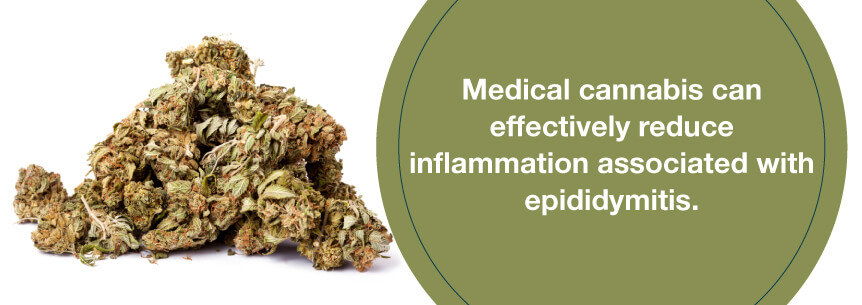
Anxiety is often challenging to live with. No matter how severe your anxiety is, it can make essential activities and tasks feel overwhelming. Marijuana and epididymitis treatment tackle anxiety effectively. The CBD cannabinoid in cannabis can benefit those struggling with various anxiety disorders. Patients often use CBD-rich cannabis products when they suffer from not just anxiety but also spasms, pain, inflammation and other symptoms.
Insomnia can impact daily living severely. Medical cannabis for epididymitis can help with insomnia as well. In fact, some individuals have reported improved sleep with cannabis use. They say it works much better than conventional sleep medications, leaves them feeling refreshed the following day and isn’t addictive.
Beware of the strain of cannabis you choose since Sativas can be mentally stimulating. Indica strains are best because they’re meant to relax you and help with sleep.
A lot of research outlines medical marijuana’s curative properties for physical conditions. But, up until recently, there hasn’t been much focus on psychological disorders and weed. Now that states are starting to legalize cannabis for medical use, researchers are beginning to find cannabis’ potential in treating psychological conditions and its ability to help those suffering from depression, which can be a symptom of epididymitis.
Some good medical marijuana and epididymitis strains to try out are:
As more individuals begin experimenting with medical pot, a big challenge they face is finding suitable consumption methods. Many are only familiar with smoking the herb and the negative stigma behind it. This is where the dilemma arises since many individuals won’t smoke cannabis regardless of how badly they might need the medicine. Fortunately, a number of other consumption methods can take the “taboo” of smoking weed out of using marijuana. Some include:
Thanks to the creativity of mankind and growing technology, people no longer have to shy away from cannabis because of constraints on consumption methods. You now have a huge selection of administration routes to choose from, even for health-conscious and conservative individuals.
To get the most from your cannabis and epididymitis treatment plan, it’s helpful for you to find a qualified medical marijuana doctor and dispensary. Your cannabis doctor can help you create your treatment plan ideal for your particular symptoms. Also, staff members at the dispensaries have adequate knowledge and experience to recommend products to you for your pain, inflammation or other symptoms.
If you suffer from epididymitis and wonder if medical cannabis can help, all you need to do is go to MarijuanaDoctors.com and perform a search for a cannabis doctor. You’ll also find marijuana dispensaries all over the U.S. with delivery information, hours, locations, reviews and more. Book your appointment at Marijuana Doctors now to begin experiencing the benefits of medical marijuana for epididymitis.
Find A Doctor Find A Dispensary
Epididymitis is a condition in which men experience inflammation of the epididymis — the tube in the back of your testicles responsible for storing and carrying sperm. When you experience swelling of this tube, it results in swelling and pain in your testicles.
Your hormones create your sperm. The two testes in your scrotum make the hormones. Sperm grow in your testes and gain maturity and movement as they travel through your epididymis.
Each one of your epididymides is connected to your ejaculatory duct by the vas deferens tube running into your inguinal canal from the lower part of your scrotum. It moves behind your bladder through your pelvis. This is the area your vas deferens, the duct transporting your sperm from the testicle to the urethra, and seminal vesicle, a gland responsible for many of the components of semen, join and form your ejaculatory duct.
Fluid from your prostate and seminal vesicles combine with sperm, forming semen when you ejaculate. Your semen then passes through your urethra and travels out the end of your penis.
Men of all ages can develop epididymitis. However, it most frequently affects men between 14 and 35 years old. A sexually transmitted disease (STD) or bacterial infection typically causes the condition. It will typically improve with antibiotics.
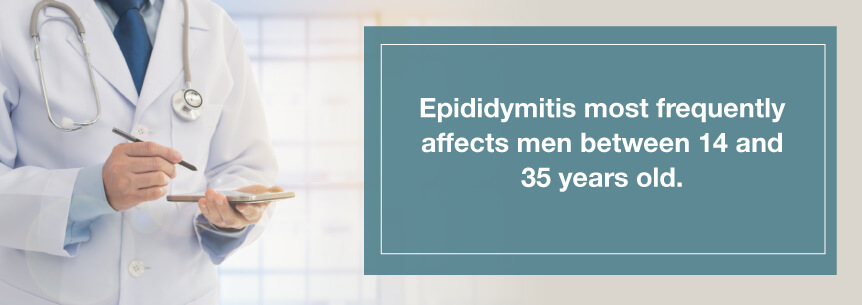
When you have acute epididymitis, it usually lasts around six weeks or less. Your testes also become inflamed with acute epididymitis in most cases — then it’s referred to as epididymo-orchitis. It’s sometimes hard to tell whether your epididymis, testes or both are inflamed, which is why many use the term epididymo-orchitis. According to the Centers for Disease Control and Prevention (CDC), the most common causes of acute epididymitis in men who are 35 years old or younger are chlamydia and gonorrhea.
On the other hand, chronic epididymitis lasts more than six weeks. You can experience pain or discomfort in your epididymis, scrotum or testicles. Granulomatous reactions may cause chronic epididymitis, resulting in calcifications or cysts.
A bacterial infection generally causes epididymitis. The bacteria move back through the prostate, vas deferens and urethra into your epididymis. In around 80 percent of cases, physicians can identify the bacteria responsible for the condition.
Two primary organism groups cause most epididymitis cases. These are coliforms, or organisms living in the intestines, and sexually transmitted organisms:
Some epididymitis risk factors include:
Epididymitis causes symptoms similar to a more severe issue known as testicular torsion where your testicle becomes turned around a cord connecting it to your body. However, symptoms of testicular torsion tend to develop a lot quicker. Torsion is also an emergency that, when not treated fast enough, could lead to you losing a testicle. When the tenderness and swelling extend into your testicle past the epididymis, it turns into epididymo-orchitis.
The types of epididymitis are:
You may only experience a few mild symptoms with epididymitis, but they often get worse if left untreated. Some symptoms you may experience include:
Some complications of epididymitis include:
Patients with chronic epididymitis often suffer from depression. In fact, each year 21.43 percent of people who are 60 years old or older and already have depression developed epididymitis, according to a study. Other co-existing conditions are anxiety, stress, bipolar disorder and insomnia.
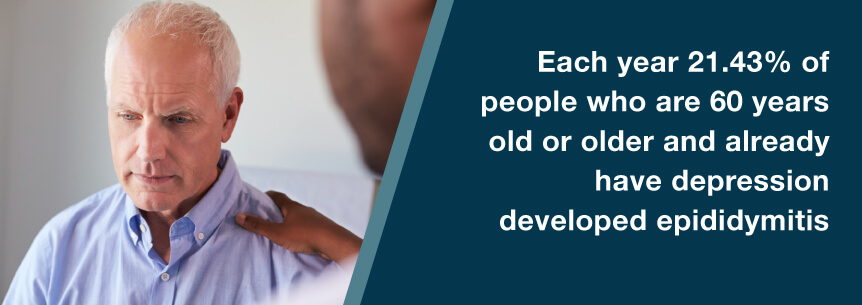
Statistics from the American Academy of Family Physicians (AAFP) show:
Your doctor will perform a physical exam on your scrotum to check for signs of infection. They’ll also inquire about your symptoms. They may even perform a rectal exam to check for tenderness in your prostate and anal area. Based on the exam, if your doctor thinks you have epididymitis, they may prescribe further testing, including:
Doctors prescribe antibiotics for epididymo-orchitis and bacterial epididymitis. If an STI caused your bacterial infection, your partner would require treatment as well.
Always finish all your antibiotics regardless of whether you start seeing an improvement in your symptoms. If you stop the antibiotics prematurely, the infection can come back even worse.
Doctors typically prescribe men with epididymitis who are younger than 39 years old one or more of the following:
For men older than 39 or who participate in anal intercourse and don’t have an STD from C. trachomatis or N. gonorrhea, these two drugs may be prescribed:
You should begin feeling better within 72 hours of beginning your antibiotics. In addition to your medication, you should also use an athletic strap to support your scrotum, rest, take pain medication and apply ice packs to relieve your pain or discomfort.
You may experience side effects from these medications, which could include nausea, vomiting, diarrhea, fever, chills, joint pain, itching, white patches on your mouth or tongue, or other side effects depending on the medication your doctor prescribes. You’ll likely have a follow-up visit with your doctor to ensure the infection has completely cleared.
If you form an abscess, you may require surgery to have it drained. In some cases, the surgeon will need to surgically remove part or all of the epididymis — known as an epididymectomy.
With this surgery, like others, you have a risk of infection. You also have a high risk of becoming sterile, and surgery relieves pain in only about half of epididymis cases.